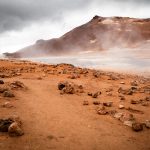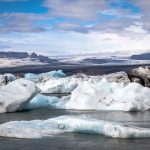In the north-east of the country Iceland’s powerhouse rages: “The falling waterfall” or better known as Dettifoss. It is regarded as the most powerful waterfall in Europe. If you stand in front of it, you’ll quickly see why!
Huge steam clouds rise above a barren rocky gorge. An earsplitting roar lies in the air. Brown-grey water masses plunge over a ridge into the depth. One feels very small in view of this demonstration of nature’s power.
Europe's most energy-rich waterfall
The force of the floods is threatening. It is not for nothing that the Dettifoss bears its title as the most energetic waterfall in Europe. A good 193 cubic metres of water fall per second over its 44-metre-high and 100-metre-wide edge. The liquid masses foam in the drop basin until they finally flow peacefully further down the river through the canyon.
-
dettifoss-iceland-17
Dettifoss, waterfall, Iceland, hydropower, travel, photography
-
Dettifoss-iceland
Dettifoss, waterfall, Iceland, hydropower, travel, photography, travel photography
-
dettifoss-iceland-12
Dettifoss, waterfall, Iceland, hydropower, travel, photography
-
dettifoss-iceland-15
Dettifoss, waterfall, Iceland, hydropower, travel, photography
-
dettifoss-iceland-18
Dettifoss, waterfall, Iceland, hydropower, travel, photography
-
dettifoss-iceland-21
Dettifoss, waterfall, Iceland, hydropower, travel, photography
-
dettifoss-iceland-11
Dettifoss, waterfall, Iceland, hydropower, travel, photography
-
dettifoss-iceland-19
Dettifoss, waterfall, Iceland, hydropower, travel, photography
-
dettifoss-iceland-3
Dettifoss, waterfall, Iceland, hydropower, travel, photography
Meltwater provides the natural spectacle
The originator of this natural spectacle is the glacial river Jökulsá á Fjöllum. With a length of 206 kilometres it is the second longest river in the country. Its source is on the northern edge of the Vatnajökull glacier. On their way to the Arctic Ocean, the Jökulsá River feeds ice runoff from its glacier tongues and numerous tributaries into a huge stream.
Jökulsárgljúfur Gorge: Crash into the canyon
Over millions of years, the glacial river has cut deep into the plateau, which is characterised by lava and ash fields. About 50 kilometres before it flows into the Greenland Sea, it flows over three waterfalls into the self-created Jökulsárgljúfur Gorge. At Dettifoss, the river already reaches its second fall stage. Its fall into the canyon begins about one kilometre north, at the twelve-metre-high Selfoss and ends two kilometres downstream at the 27-metre-high Hafragilsfoss.
-
dettifoss-iceland-8
Dettifoss, waterfall, Iceland, basalt, rock, water vapor, water power, travel, photography, travel photography
-
dettifoss-iceland-9
Dettifoss, waterfall, Iceland, basalt, rock, water vapor, water power, travel, photography, travel photography
-
dettifoss-iceland-16
Dettifoss, waterfall, Iceland, basalt, rock, water vapor, water power, travel, photography, travel photography, waterfall
-
dettifoss-iceland-13
Dettifoss, waterfall, Iceland, basalt, rock, water vapor, water power, travel, photography, travel photography, waterfall
Artworks of basalt rocks
Since 2008, the Jökulsárgljúfur Gorge has been part of the Vatnajökull National Park, which is 25 kilometres long and over 100 metres deep. Its jagged texture of stepped basalt rock is revealed at Dettifoss with its mystical appearance. Like an artwork, broken basalt columns pile up at the downside area of the canyon. Wrapped in the damp mist of the waterfall this sight seems to be borrowed from a fantasy film.
Best travel time, directions, tours & accommodations
Dettifoss can be visited all year round. The experience in the summer months between May and September is much more beautiful and relaxed than in winter. On the one hand, the days are much longer bright. On the other hand, the waterfall is partially frozen during the winter months. Wind and ice can disturb not only the approach but also the ascent. Attention: The damp bank areas at Dettifoss are not secured! Therefore, tread resistance is an important prerequisite for safety not only in winter.
Dettifoss is about 150 kilometres away from the capital of the north – Akureyri. From Akureyri you can get there by car in about two hours. Two roads lead from ring road to Dettifoss: one to the west side and the other to the east side of the waterfall. The more comfortable route leads over 862 for about 20 kilometres along the west bank of the Jökulsá and ends at a large car parking on the west side of the waterfall. The other variant leads along 864 for about 30 kilometres on a gravel road and ends at a small parking lot on the east side of Dettifoss. Despite the inconvenience of the journey, the east side is very recommendable because of its beauty. The view of the waterfall is much more impressive than on the west side. As rental cars are not insured on unpaved roads, one should only drive to the east side with an four-wheel drive vehicle.
In the area of Dettifoss waterfall there is a variety of accommodation in the form of hotels and guesthouses. Beautiful campsites in the area include the Asbyrgi Camp Site and the Jökulsárgljúfur/Ásbyrgi Campground.
For a trip to Dettifoss there are different possibilities: Either you book an organized tour or you travel with your own car. Numerous organizers offer various tours to the Diamond Circle as a day trip. In addition to the Dettifoss, a Diamond Circle Tour includes visits to the Asbyrgi Gorge, the Myvátn Region and the Godafoss Waterfall.
Self-drivers have the advantage that they can divide their time individually. A visit to Dettifoss can be ideally integrated into a round trip. Beyond the round trip a two to four day tour through the northeast of Iceland is recommendable. An absolute must are also stops at the Asbyrgi gorge, the Myvátn region with the high temperature area Námafjall as well as the Godafoss waterfall. In two to four days there is enough time for a detailed visit of all sights.
Camera tips: equipment & photo motifs
For good photos, a wide-angle and a telephoto lens (ideal from 15mm or 200mm focal length) should always be included. As an alternative a zoom lens (e.g. 28-105mm focal length) is also suitable. However, the aperture range (from 3.5 – 5.6 F) of the zoom lens should not be too small.
For really impressive pictures we recommend day times around sunset. The soft evening light makes the waterfall look particularly powerful. Due to its size, Dettifoss is ideal for panorama shots.
There are two ways to put the floods of the Dettifoss in the limelight. The movement of the water can be frozen via very short exposure times. The water is given a flowing, almost silky appearance with a long-time exposure. Due to its powerful movement, the Dettifoss is also ideal for a short video clip – either normal or slow motion.
Könnte Dich auch interessieren!
-
Surreal: Geothermal area Namafjall Hverir
Just a stone's throw away from the tranquil Lake Myvatn, the door opens to a surreal world. In the Georhermal region of Namafjall Hverir, probably Iceland's most impressive solfatar field, volcanic activity is at hand.
-
Iceland's icy pearl: Glacier lagoon Jökulsárlón
In the southeast of the island, Iceland hides it's crown jewels: The glacier lagoon Jökulsárlón and the nearby Diamond Beach. Its bright colours seem almost unreal and reveal the creative power of nature.
-
In service of culture: The elf researcher
Actually, Icelanders have both feet firmly on the ground in the 21st century. Nevertheless, they have an extraordinary connection to the supernatural. More than half the population believes in elves and other hidden beings. One of them is elf researcher…



